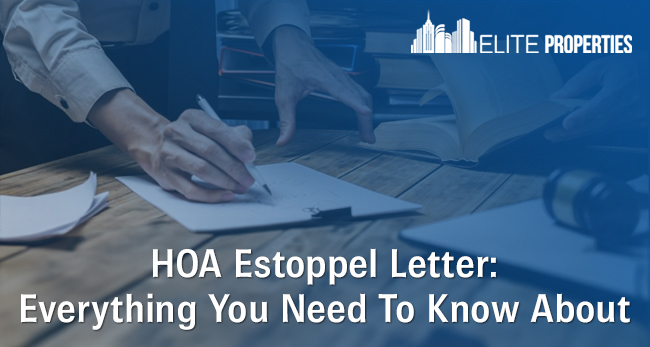HOA estoppel letter is a vital part of any real estate transaction. They provide information to prospective buyers, providing details such as the HOA’s name and contact information, property address, and outstanding financial obligations.
They’re also used by lenders to take real property as security, outlining the terms of the agreement between the lender and the association.
In addition to being an important document in real estate transactions, they’re also used by parties involved in a dispute over association fees or dues.
HOA estoppel letters are helpful for many reasons. But one of the most notable is that they help ease the transition from a current owner to a new one. With this letter, parties involved in a real estate transaction have all the information they would need to know.
Essentially an HOA estoppel letter is used for closing real estate deals and can help avoid potential disputes.
Let’s try to understand more about the HOA Estoppel letter and how useful can it be.
What Is An HOA Estoppel Letter?
HOA Estoppel is a legally binding document that certifies the amount of money a home seller owes to the homeowner association.
The document includes any delinquent amounts due from the seller, any amounts that may be payable to an attorney handling a collection matter on the subject property, and any fees associated with closing escrow.
In some cases, homeowners’ association estoppel letters can serve as the certificate of title for real estate.
In a nutshell, real estate agents and lenders who require additional documentation for loan approval typically use homeowners’ association estoppel letters as proof of title.
Additionally, homeowners’ association estoppel letters are often included in homeowner association closing statements and closing documents when escrow is being facilitated by a real estate agent or lender.
What Does An HOA Estoppel Letter Include?
HOA estoppel letters typically contain information related to homeowner association dues and assessments, such as:
- dates of assessment and payment;
- types of fees assessed;
- total amount due;
- instructions for paying the fees;
and more. In some cases, homeowners’ association estoppel letters include a lien or deed restriction statement that certifies the owner’s current dues and assessment payments.
The HOA should include instructions on how to make payment. It should include a note stating that one cannot add newly discovered debts to an already submitted Estoppel letter.
In general, an Estoppel letter should include a comprehensive overview of the homeowners association’s financial obligations and conditions. I do not believe it should be overly detailed or tedious to read.
It should provide enough information for potential property owners to understand their financial obligations and obligations under the association’s bylaws.
How Does A Buyer Obtain An Estoppel Letter?
To obtain an estoppel letter, a buyer typically obtains one from the homeowners association board through the title search company they are working with.
This letter provides information regarding the seller’s annual fees and any outstanding payments due at the time of sale.
The HOA must provide the estoppel letter. And an authorized representative from the association must complete and sign the document within 10 business days. The association must designate a person or entity with a street or email address for the receipt of a request for an estoppel letter, and this information must be publicly available online.
This information can help buyers make informed decisions about purchasing a property in an HOA jurisdiction. A buyer can also contact the association for additional details about their estoppel letter.
What Happens If The Seller Doesn’t Owe The HOA Any Fees?
If the estoppel letter does not indicate any outstanding fees owed by the seller to the HOA, the buyer is not responsible for any fees belonging to the current owner.
Additionally, the buyer is provided with a warranty deed from the seller. This deed ensures that the title of the property is clear and that the seller holds a clear title to it.
However, the party who demands it must provide the estoppel letter and pay the fee, even if the seller has no unpaid balance.
The estoppel letter ensures no additional costs are associated with purchasing a property with an outstanding HOA balance. It also serves as proof of ownership upon closing. In this way, it provides additional assurance to both buyers and sellers of property with an outstanding balance.
What Does An HOA Estoppel Letter Cost?
The cost of preparing an estoppel certificate normally cannot exceed $299 as of July 1, 2022. If an association receives an urgent request for the estoppel certificate and provides it in less than three working days, it may charge up to an extra $119.00. The association may also impose an extra fee for delinquent accounts, not to exceed $179.
Bottom Line
Homeowners’ associations commonly use estoppel letters to support claims regarding the terms of association agreements.
It typically contains specific facts and information about a particular situation. It can be the date of the agreement, the scope of the agreement, or any other relevant information.
As a buyer, you must get an HOA estoppel letter from the association before purchasing into an HOA. This will let you know if there are any unpaid fees related to a property before closing.
The HOA estoppel letter allows the buyer to take possession of the property free of any encumbrances. It also protects against any claims by the HOA after closing.
An estoppel letter protects all parties and allows you to restart without having to pay someone else’s expenses right away.
When you have extensive support from professionals, real estate transactions become simpler. The goal of New York-based Elite Properties is to simplify the buying and selling process.
For more in-depth guidance on HOA estoppel letters, get in touch now!

